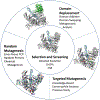Engineering Polymerases for New Functions
- PMID: 31003719
- PMCID: PMC6745271
- DOI: 10.1016/j.tibtech.2019.03.011
Engineering Polymerases for New Functions
Abstract
DNA polymerases are critical tools in biotechnology, enabling efficient and accurate amplification of DNA templates, yet many desired functions are not readily available in natural DNA polymerases. New or improved functions can be engineered in DNA polymerases by mutagenesis or through the creation of protein chimeras. Engineering often necessitates the development of new techniques, such as selections in water-in-oil emulsions that connect genotype to phenotype and allow more flexibility in engineering than phage display. Engineering efforts have led to DNA polymerases that can withstand extreme conditions or the presence of inhibitors, as well as polymerases with the ability to copy modified DNA templates. In this review we discuss polymerases for biotechnology that have been reported along with tools to enable further development.
Keywords: DNA damage; DNA modification; DNA polymerase; fidelity; processivity.
Copyright © 2019 Elsevier Ltd. All rights reserved.
Figures



Similar articles
-
Archaeal DNA polymerases in biotechnology.Appl Microbiol Biotechnol. 2015 Aug;99(16):6585-97. doi: 10.1007/s00253-015-6781-0. Epub 2015 Jul 7. Appl Microbiol Biotechnol. 2015. PMID: 26150245 Review.
-
Engineering polymerases for applications in synthetic biology.Q Rev Biophys. 2020 Jul 27;53:e8. doi: 10.1017/S0033583520000050. Q Rev Biophys. 2020. PMID: 32715992 Review.
-
Expanding the substrate repertoire of a DNA polymerase by directed evolution.J Am Chem Soc. 2004 Feb 18;126(6):1748-54. doi: 10.1021/ja038525p. J Am Chem Soc. 2004. PMID: 14871106
-
Functional Comparison of Laboratory-Evolved XNA Polymerases for Synthetic Biology.ACS Synth Biol. 2021 Jun 18;10(6):1429-1437. doi: 10.1021/acssynbio.1c00048. Epub 2021 May 24. ACS Synth Biol. 2021. PMID: 34029459
-
Engineered DNA polymerases in biotechnology.Chembiochem. 2010 Oct 18;11(15):2077-84. doi: 10.1002/cbic.201000215. Chembiochem. 2010. PMID: 20862762 Review. No abstract available.
Cited by
-
Characteristics of DNA polymerase I from an extreme thermophile, Thermus scotoductus strain K1.Microbiologyopen. 2021 Jan;10(1):e1149. doi: 10.1002/mbo3.1149. Epub 2021 Jan 7. Microbiologyopen. 2021. PMID: 33415847 Free PMC article.
-
DNA storage-from natural biology to synthetic biology.Comput Struct Biotechnol J. 2023 Feb 2;21:1227-1235. doi: 10.1016/j.csbj.2023.01.045. eCollection 2023. Comput Struct Biotechnol J. 2023. PMID: 36817961 Free PMC article. Review.
-
Selective RNA Labeling by RNA-Compatible Type II Restriction Endonuclease and RNA-Extending DNA Polymerase.Life (Basel). 2022 Oct 21;12(10):1674. doi: 10.3390/life12101674. Life (Basel). 2022. PMID: 36295109 Free PMC article.
-
Thermophilic Nucleic Acid Polymerases and Their Application in Xenobiology.Int J Mol Sci. 2022 Nov 29;23(23):14969. doi: 10.3390/ijms232314969. Int J Mol Sci. 2022. PMID: 36499296 Free PMC article. Review.
-
Multiplex one-step direct asymmetric PCR of blood and dual-labelled probe-mediated melting curve for genotyping of MTHFR and MTRR polymorphisms.RSC Adv. 2025 Jan 2;15(1):75-82. doi: 10.1039/d4ra07286c. eCollection 2025 Jan 2. RSC Adv. 2025. PMID: 39758893 Free PMC article.
References
Publication types
MeSH terms
Substances
Grants and funding
LinkOut - more resources
Full Text Sources
Other Literature Sources

